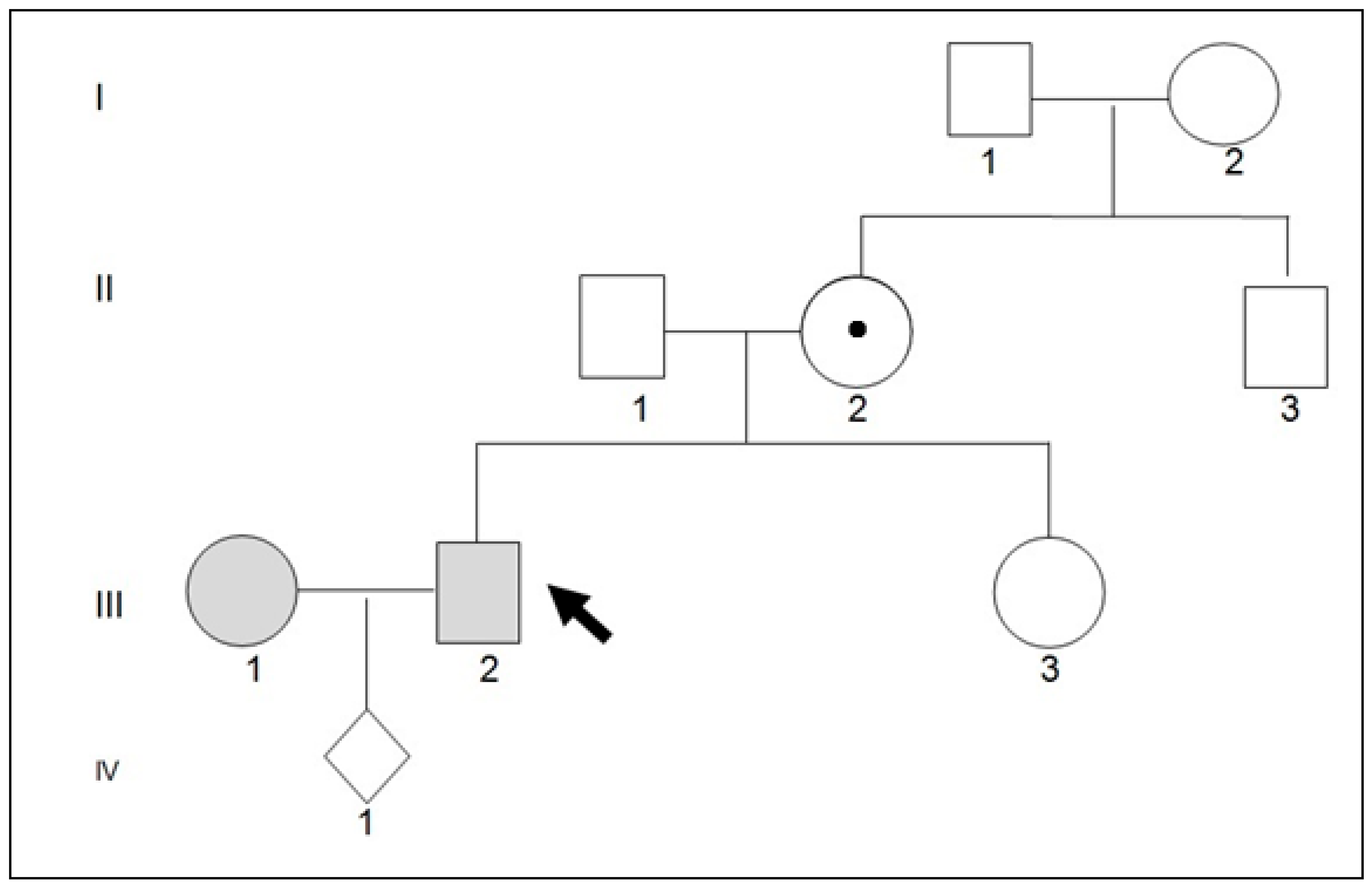Genotype–Phenotype Correlation in a Couple in Which the Wife Is a Carrier of the Beta-Thalassemia Trait and the Husband Is a Carrier of a Mutation in the ALAS2 Gene: Both Gene Defects Are Associated with Non-Iron-Deficiency Microcytic Anemia
Abstract
1. Introduction
2. Detailed Case Description
3. Discussion and Conclusions
Author Contributions
Funding
Institutional Review Board Statement
Informed Consent Statement
Data Availability Statement
Acknowledgments
Conflicts of Interest
References
- Ekpe, A.C.; Adefemi, S.A.; Pemi, M.D. Predictors of Anaemia among Pregnant Women Booking for Antenatal Care at Federal Medical Centre, Bida, Niger State, Nigeria. West Afr. J. Med. 2023, 40, 831–837. [Google Scholar] [PubMed]
- Ducamp, S.; Fleming, M.D. The molecular genetics of sideroblastic anemia. Blood 2019, 133, 59–69. [Google Scholar] [CrossRef] [PubMed]
- O’Toole, F.; Sheane, R.; Reynaud, N.; McAuliffe, F.M.; Walsh, J.M. Screening and treatment of iron deficiency anemia in pregnancy: A review and appraisal of current international guidelines. Int. J. Gynaecol. Obstet. 2023, 9, 214–227. [Google Scholar] [CrossRef] [PubMed]
- Dell’Edera, D.; Pacella, E.; Epifania, A.A.; Benedetto, M.; Tinelli, A.; Mazzone, E.; Laterza, F.; Malvasi, A. Importance of molecular biology in the characterization of beta-thalassemia carriers. Eur. Rev. Med. Pharmacol. Sci. 2011, 15, 79–86. [Google Scholar] [PubMed]
- Dell’Edera, D.; Vitucci, A.; Andrisani, G.; Epifania, A.A. Limitations of the biochemical research in the identification of the thalassemic trait carrier. Minerva Ginecol. 2016, 68, 478–479. [Google Scholar] [PubMed]
- Ono, K.; Fujiwara, T.; Saito, K.; Nishizawa, H.; Takahashi, N.; Suzuki, C.; Ochi, T.; Kato, H.; Ishii, Y.; Onodera, K.; et al. Congenital sideroblastic anemia model due to ALAS2 mutation is susceptible to ferroptosis. Sci. Rep. 2022, 12, 9024. [Google Scholar] [CrossRef] [PubMed]
- Rollón, N.; Fernández-Jiménez, M.C.; Moreno-Carralero, M.I.; Murga-Fernández, M.J.; Morán-Jiménez, M.J. Microcytic anemia in a pregnant woman: Beyond iron deficiency. Int. J. Hematol. 2015, 101, 514–519. [Google Scholar] [CrossRef] [PubMed]
- Matthes, T.; Rustin, P.; Trachsel, H.; Darbellay, R.; Costaridou, S.; Xaidara, A.; Rideau, A.; Beris, P. Different pathophysiological mechanisms of intramitochondrial iron accumulation in acquired and congenital sideroblastic anemia caused by mitochondrial DNA deletion. Eur. J. Haematol. 2006, 77, 169–174. [Google Scholar] [CrossRef] [PubMed]

| Blood Levels | ||
|---|---|---|
| Normal Values | ||
| Erythrocytes 106/µL | 5.87↑ | 4.0–5.60 |
| Hb g/dL | 12.4 | 12.8–16.5 |
| MCV fl | 69.9↓ | 80–98 |
| MCH pg | 21.1↓ | 27–32 |
| MCHC g/dL | 30.2↓ | 31.0–37.0 |
| HCT % | 41.1 | 41–53 |
| PLT 103/µL | 116.0↓ | 150–450 |
| RDW-CV % | 33.8↑ | 11.0–15.0 |
| HbA2 % | 2.2 | <3.2 |
| HbF % | 0.7 | <1.0 |
| Serum ferritin ng/mL | 170.0 | 22–322 |
| serum iron µg/dL | 261.0↑ | Male: 80–180 Female: 60–160 |
| transferrin mg/dL | 170 | 200–360 |
| % transferrin saturation | 57↑ | 15–55 |
| Blood Levels | ||||
|---|---|---|---|---|
| Proband: Pe. Gi.(III2) | Father (II1) | Mother (II3) | Normal Values | |
| Erythrocytes 106/µL | 5.87↑ | 5.03 | 5.15 | 4.0–5.60 |
| Hb g/dL | 12.4 | 15.0 | 13.40 | 12.8–16.5 |
| MCV fl | 69.9↓ | 93.0 | 83.4 | 80–98 |
| MCH pg | 21.1↓ | 29.7 | 26.0↓ | 27–32 |
| MCHC g/dL | 30.2↓ | 32.0 | 31.2 | 31.0–37.0 |
| HCT % | 41.1 | 46.8 | 42.9 | 41–53 |
| PLT 103/µL | 116.0↓ | 145.0↓ | 203.0 | 150–450 |
| HbA2 % | 2.2 | 2.6 | 2.5 | <3.2 |
| HbF % | 0.6 | 0.3 | 0.4 | <1.0 |
| Serum ferritin ng/mL | 170.0 | 133.0 | 83.0 | 22–322 |
| Serum iron µg/dL | 261.0↑ | 83.0 | 140.0 | Male: 80–180 Female: 60–160 |
Disclaimer/Publisher’s Note: The statements, opinions and data contained in all publications are solely those of the individual author(s) and contributor(s) and not of MDPI and/or the editor(s). MDPI and/or the editor(s) disclaim responsibility for any injury to people or property resulting from any ideas, methods, instructions or products referred to in the content. |
© 2024 by the authors. Licensee MDPI, Basel, Switzerland. This article is an open access article distributed under the terms and conditions of the Creative Commons Attribution (CC BY) license (https://creativecommons.org/licenses/by/4.0/).
Share and Cite
Dell’Edera, D.; Centoducati, C.; Allegretti, A.; La Rocca, F.; Persia, B. Genotype–Phenotype Correlation in a Couple in Which the Wife Is a Carrier of the Beta-Thalassemia Trait and the Husband Is a Carrier of a Mutation in the ALAS2 Gene: Both Gene Defects Are Associated with Non-Iron-Deficiency Microcytic Anemia. Thalass. Rep. 2024, 14, 118-121. https://doi.org/10.3390/thalassrep14040012
Dell’Edera D, Centoducati C, Allegretti A, La Rocca F, Persia B. Genotype–Phenotype Correlation in a Couple in Which the Wife Is a Carrier of the Beta-Thalassemia Trait and the Husband Is a Carrier of a Mutation in the ALAS2 Gene: Both Gene Defects Are Associated with Non-Iron-Deficiency Microcytic Anemia. Thalassemia Reports. 2024; 14(4):118-121. https://doi.org/10.3390/thalassrep14040012
Chicago/Turabian StyleDell’Edera, Domenico, Carmela Centoducati, Arianna Allegretti, Francesco La Rocca, and Brunilde Persia. 2024. "Genotype–Phenotype Correlation in a Couple in Which the Wife Is a Carrier of the Beta-Thalassemia Trait and the Husband Is a Carrier of a Mutation in the ALAS2 Gene: Both Gene Defects Are Associated with Non-Iron-Deficiency Microcytic Anemia" Thalassemia Reports 14, no. 4: 118-121. https://doi.org/10.3390/thalassrep14040012
APA StyleDell’Edera, D., Centoducati, C., Allegretti, A., La Rocca, F., & Persia, B. (2024). Genotype–Phenotype Correlation in a Couple in Which the Wife Is a Carrier of the Beta-Thalassemia Trait and the Husband Is a Carrier of a Mutation in the ALAS2 Gene: Both Gene Defects Are Associated with Non-Iron-Deficiency Microcytic Anemia. Thalassemia Reports, 14(4), 118-121. https://doi.org/10.3390/thalassrep14040012






